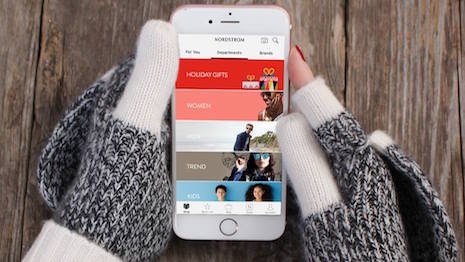 Image source Neiman Marcus
Image source Neiman Marcus
Research is showing that Gen Z and millennials are uninterested in shopping at luxury department stores, a trend that will become increasingly problematic for high-end retailers as the demographic ages.
Crowdsourcing savings platform Dealspotr released a survey on generations and their shopping habits, which showed luxury department stores becoming increasingly unpopular amongst all age groups. However, Nordstrom remains a strong retailer with Generation X- and baby boomer-aged consumers.
"Department stores performed poorly among teens and Millennial shoppers," said Michael Quoc, CEO and founder of Dealspotr, Santa Monica, CA "Department stores performed well among older, Gen-X and boomer, shoppers, with Target, Kohl's, Nordstrom and TJ Maxx topping the list.
"Target was a standout among department stores, and is popular among millennials, Gen-X and boomers," he said. "Among department stores, only discounters Target, and to a lesser extent TJ Maxx, performed well among millennials and teens.
"Luxury department stores (Nordstrom, Neiman Marcus and Bloomingdale's) performed poorly. They ranked among the bottom for teens and millennials, and only Nordstrom performed well among Gen-X and boomers."
Dealspotr surveyed 303 shoppers in March 2017. The surveyed group comprised of 81 percent women and 19 percent men.
Department stores fading
Department store chains Neiman Marcus and Bloomingdale’s ranked among the bottom of the rankings in regards to shopping preference.
Mass market retailer Target was the exception to younger age group’s aversion to department stores. Also, online commerce giant Amazon remains the most popular preference in purchasing fashion apparel and accessories by far.
 Amazon remains popular
Generation Z is more likely than any other age group to research online and then visit bricks-and-mortar to purchase apparel.
While consumers are becoming more comfortable with shopping online, mobile retail ranks at the bottom of preference for all age groups compared to all forms of shopping.
However, mobile is still extremely popular in the customer journey with 39 percent of millennials and 37 percent of Gen X and baby boomers claiming they do most of their fashion browsing on their phones.
Amazon remains popular
Generation Z is more likely than any other age group to research online and then visit bricks-and-mortar to purchase apparel.
While consumers are becoming more comfortable with shopping online, mobile retail ranks at the bottom of preference for all age groups compared to all forms of shopping.
However, mobile is still extremely popular in the customer journey with 39 percent of millennials and 37 percent of Gen X and baby boomers claiming they do most of their fashion browsing on their phones.
 Nordstrom's mobile app
Completing a purchase in store is the most popular form of checking out with tablets and laptops following behind in second.
Coupon offers is still a big driver in where consumers shop, with Nordstrom ranking high in terms of favorability with coupons in teens.
Additional insights
While luxury buyers are primarily older, millennials will soon make up 40 percent of all luxury purchases, according to research from Bain & Company and online retailer Farfetch.
Additionally, older consumers are tending to adopt the shopping trends of younger consumers. This means that luxury brands will have to pay even more attention to the ways that millennials shop for luxury goods (see more).
Apparel and accessories brands need to progress much further in an omnichannel strategy, as millennials’ shopping experience spans a multitude of channels, starting online for product discovery and ending with purchasing on any given platform.
According to the Criteo Apparel Trend Report, millennials are now more omnichannel than ever, looking up product information and trends on social and online, but any on whichever platform they choose. Retailers and brands need to close the gap between these platforms and focus on an experience that spans all channels (see more).
"Generation Z, also called 'millennials on steroids,' are now graduating from college and entering the workforce," Mr. Quoc said. "How does the first truly digital native generation shop for fashion?
"How are Millennials shopping these days," he said. "How do these trends compare to older shoppers?
"We wanted to find out, and gained some valuable insights in our annual 2017 fashion shopping habits survey."
Nordstrom's mobile app
Completing a purchase in store is the most popular form of checking out with tablets and laptops following behind in second.
Coupon offers is still a big driver in where consumers shop, with Nordstrom ranking high in terms of favorability with coupons in teens.
Additional insights
While luxury buyers are primarily older, millennials will soon make up 40 percent of all luxury purchases, according to research from Bain & Company and online retailer Farfetch.
Additionally, older consumers are tending to adopt the shopping trends of younger consumers. This means that luxury brands will have to pay even more attention to the ways that millennials shop for luxury goods (see more).
Apparel and accessories brands need to progress much further in an omnichannel strategy, as millennials’ shopping experience spans a multitude of channels, starting online for product discovery and ending with purchasing on any given platform.
According to the Criteo Apparel Trend Report, millennials are now more omnichannel than ever, looking up product information and trends on social and online, but any on whichever platform they choose. Retailers and brands need to close the gap between these platforms and focus on an experience that spans all channels (see more).
"Generation Z, also called 'millennials on steroids,' are now graduating from college and entering the workforce," Mr. Quoc said. "How does the first truly digital native generation shop for fashion?
"How are Millennials shopping these days," he said. "How do these trends compare to older shoppers?
"We wanted to find out, and gained some valuable insights in our annual 2017 fashion shopping habits survey."
